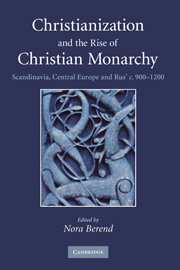Book contents
- Frontmatter
- Contents
- Contributors
- List of maps
- Acknowledgements
- Note
- List of common abbreviations
- Chapter 1 Introduction
- Chapter 2 From paganism to Christianity in medieval Europe
- Chapter 3 The kingdom of Denmark
- Chapter 4 The kingdom of Norway
- Chapter 5 The kingdom of Sweden
- Chapter 6 Bohemia and Moravia
- Chapter 7 The Kingdom of Poland, with an Appendix on Polabia and Pomerania between paganism and Christianity
- Chapter 8 The kingdom of Hungary
- Chapter 9 Rus'
- Index
- References
Chapter 1 - Introduction
Published online by Cambridge University Press: 24 June 2009
- Frontmatter
- Contents
- Contributors
- List of maps
- Acknowledgements
- Note
- List of common abbreviations
- Chapter 1 Introduction
- Chapter 2 From paganism to Christianity in medieval Europe
- Chapter 3 The kingdom of Denmark
- Chapter 4 The kingdom of Norway
- Chapter 5 The kingdom of Sweden
- Chapter 6 Bohemia and Moravia
- Chapter 7 The Kingdom of Poland, with an Appendix on Polabia and Pomerania between paganism and Christianity
- Chapter 8 The kingdom of Hungary
- Chapter 9 Rus'
- Index
- References
Summary
THE PROJECT
This book is the product of a year-long research project I organized, conducted in collaboration with the Centre for Medieval Studies at the University of Bergen, and with scholars from several countries. Together, we agreed on a set of questions to be addressed, read each other's rough drafts and held a series of workshop discussions in common, so that the book is not a collection of articles, but a coherent whole where all chapters address the same issues. We worked as a team and all the participants contributed more than their particular chapter in this volume; in a way the entire book, including this introduction, is the result of our common work.
The extension of Christendom's frontiers by the Christianization of Scandinavia and central-eastern Europe, a process also linked to the formation of new principalities and kingdoms, was one of the most fundamental stages in the formation of Europe. It resulted in the incorporation of large swaths of land into a political system that eventually gave rise to the European states as we know them. In the medieval ‘making of Europe’, one can distinguish between several regions: areas that joined Christian Europe under the leadership of their own elite, and those that either remained outside Christendom or were subjugated by force. We focused on the first, where two developments coincided in time: as Christianity was introduced, local rulers also consolidated their power over these areas.
- Type
- Chapter
- Information
- Christianization and the Rise of Christian MonarchyScandinavia, Central Europe and Rus' c.900–1200, pp. 1 - 46Publisher: Cambridge University PressPrint publication year: 2007
References
- 17
- Cited by



